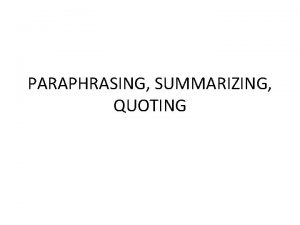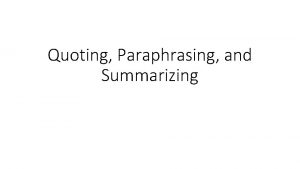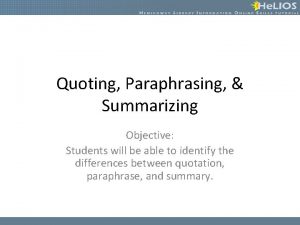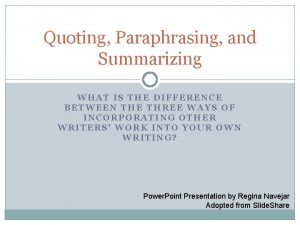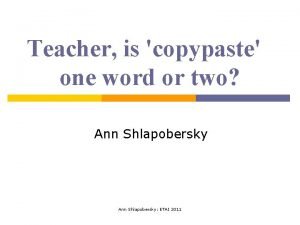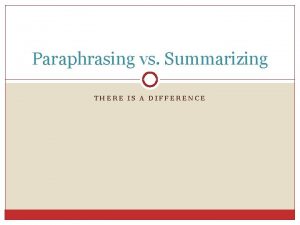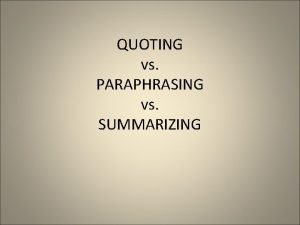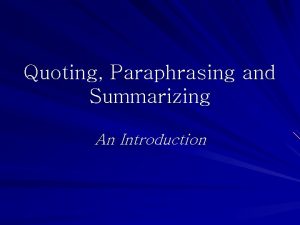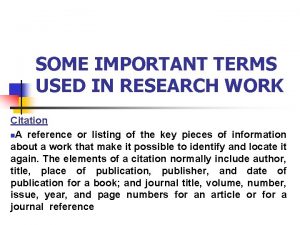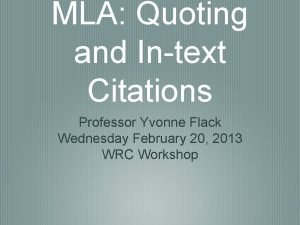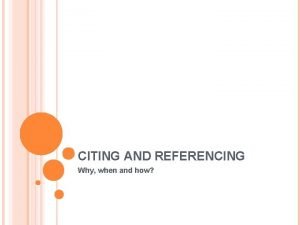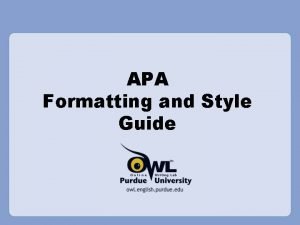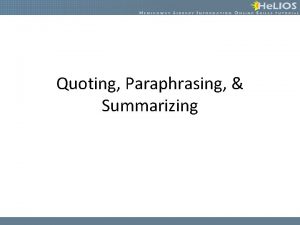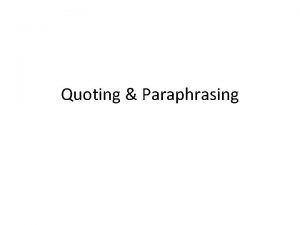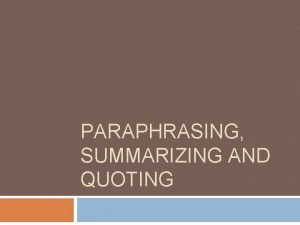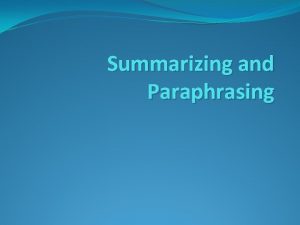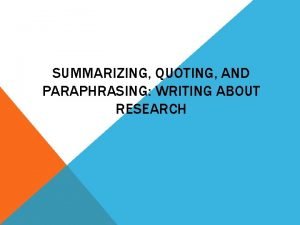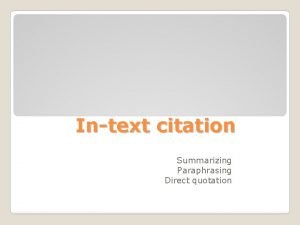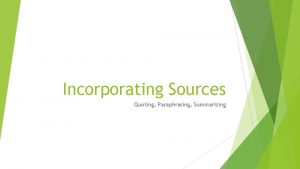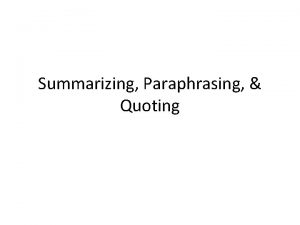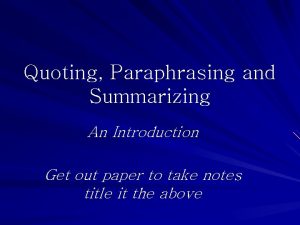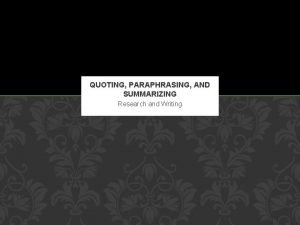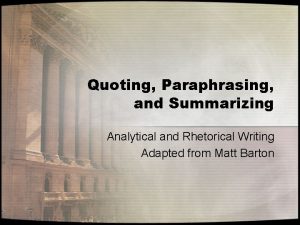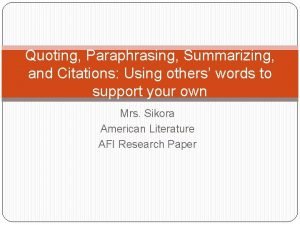Quoting Paraphrasing and Summarizing An Introduction Whats the















- Slides: 15

Quoting, Paraphrasing and Summarizing An Introduction

What’s the difference? Quotations must be identical to the original. They must match the source document word for word and must be attributed to the original author. Paraphrasing involves putting a passage from source material into your own words. A paraphrase must also be attributed to the original source. Paraphrased material is usually shorter than the original passage, taking a somewhat broader segment of the source and condensing it slightly. Summarizing involves putting the main idea(s) into your own words, including only the main point(s). Once again, it is necessary to attribute summarized ideas to the original source. Summaries are significantly shorter than the original and take a broad overview of the source material.

Why should I use them? provide support for claims or add credibility to your writing refer to work that leads up to the work you are now doing give examples of several points of view on a subject call attention to a position that you wish to agree or disagree with highlight a particularly striking phrase, sentence, or passage by quoting the original distance yourself from the original by quoting it in order to cue readers that the words are not your own expand the breadth or depth of your writing

How do I start? Read the entire text, noting the key points and main ideas. Summarize in your own words what the single main idea of the essay is. Paraphrase important supporting points that come up in the essay. Consider any words, phrases, or brief passages that you believe should be quoted directly

Paraphrasing A paraphrase is. . . your own rendition of essential information and ideas expressed by someone else, presented in a new form. one legitimate way (when accompanied by accurate documentation) to borrow from a source. a more detailed restatement than a summary, which focuses concisely on a single main idea.

Paraphrasing is a valuable skill because. . . it is better than quoting information from an undistinguished passage. it helps you control the temptation to quote too much. the mental process required for successful paraphrasing helps you to grasp the full meaning of the original.

Paraphrasing 6 Steps to Effective Paraphrasing 1. Reread the original passage until you understand its full meaning. 2. Set the original aside, and write your paraphrase on a note card. 3. Jot down a few words below your paraphrase to remind you later how you envision using this material. At the top of the note card, write a key word or phrase to indicate the subject of your paraphrase. 4. Check your rendition with the original to make sure that your version accurately expresses all the essential information in a new form. 5. Use quotation marks to identify any unique term or phraseology you have borrowed exactly from the source. 6. Record the source (including the page) on your note card so that you can credit it easily if you decide to incorporate the material into your paper.

Summarizing A summary is much shorter than the original text. It should communicate the main idea of the text and the main supporting points – written ‘in your own words’. – in a very brief form. It should give someone who has not read the original a clear and accurate overview of the text.

Summarizing To summarize Record the author, title, year of publication and source of the text. Skim the text. Note any sub-headings, or try to divide the text into sections. Read the text carefully. Use a dictionary if necessary, and be prepared to read very difficult texts more than once. Pay special attention to the first and last paragraphs. Try to identify the main idea or argument. Identify the topic sentence in each paragraph. Identify the main support for the topic sentence. Write the topic sentence of your summary. Include the author’s name, the title of the text, the year of publication and the author’s main idea or argument

What’s plagiarism? Plagiarism is using others’ ideas and words without clearly acknowledging the source of that information. – To avoid plagiarism, you must give credit whenever you use: another person’s idea, opinion, or theory; any facts, statistics, graphs, drawings—any pieces of information—that are not common knowledge; quotations of another person’s actual spoken or written words; or paraphrase of another person’s spoken or written words.

Good or Bad? Here’s the ORIGINAL text, from page 1 of Lizzie Borden: A Case Book of Family and Crime in the 1890 s by Joyce Williams et al. : The rise of industry, the growth of cities, and the expansion of the population were three great developments of late nineteenth century American history. As new, larger, steam-powered factories became a feature of the American landscape in the East, they transformed farm hands into industrial laborers, and provided jobs for a rising tide of immigrants. With industry came urbanization the growth of large cities (like Fall River, Massachusetts, where the Bordens lived) which became the centers of production as well as of commerce and trade. Here’s an UNACCEPTABLE paraphrase that is plagiarism: The increase of industry, the growth of cities, and the explosion of the population were three large factors of nineteenth century America. As steam-driven companies became more visible in the eastern part of the country, they changed farm hands into factory workers and provided jobs for the large wave of immigrants. With industry came the growth of large cities like Fall River where the Bordens lived which turned into centers of commerce and trade as well as production.

WHY? ? The preceding passage is considered plagiarism for two reasons: the writer has only changed around a few words and phrases, or changed the order of the original’s sentences. the writer has failed to cite a source for any of the ideas or facts. If you do either or both of these things, you are plagiarizing. NOTE: This paragraph is also problematic because it changes the sense of several sentences (for example, "steam-driven companies" in sentence two misses the original’s emphasis on factories).

Good or Bad? Here’s the ORIGINAL text, from page 1 of Lizzie Borden: A Case Book of Family and Crime in the 1890 s by Joyce Williams et al. : The rise of industry, the growth of cities, and the expansion of the population were three great developments of late nineteenth century American history. As new, larger, steam-powered factories became a feature of the American landscape in the East, they transformed farm hands into industrial laborers, and provided jobs for a rising tide of immigrants. With industry came urbanization the growth of large cities (like Fall River, Massachusetts, where the Bordens lived) which became the centers of production as well as of commerce and trade Here’s an ACCEPTABLE paraphrase: Fall River, where the Borden family lived, was typical of northeastern industrial cities of the nineteenth century. Steam-powered production had shifted labor from agriculture to manufacturing, and as immigrants arrived in the US, they found work in these new factories. As a result, populations grew, and large urban areas arose. Fall River was one of these manufacturing and commercial centers (Williams 1).

WHY? ? This is acceptable paraphrasing because the writer: accurately relays the information in the original uses her own words. lets the reader know the source of his/her information.

Questions? ?
 Try to practice paraphrasing summarizing and direct quoting
Try to practice paraphrasing summarizing and direct quoting 4-2 reading quoting paraphrasing and summarizing
4-2 reading quoting paraphrasing and summarizing Quoting summarizing and paraphrasing
Quoting summarizing and paraphrasing Quoting, paraphrasing and summarizing examples
Quoting, paraphrasing and summarizing examples Compare paraphrasing summarizing and direct quoting
Compare paraphrasing summarizing and direct quoting Difference between summarising and paraphrasing
Difference between summarising and paraphrasing Paraphrasing vs summarizing
Paraphrasing vs summarizing Paraphrasing vs summarizing
Paraphrasing vs summarizing Direct material sourcing and quoting
Direct material sourcing and quoting Whats paraphrasing
Whats paraphrasing Three authors citation
Three authors citation Quoting dialogue
Quoting dialogue Macbeth citation mla
Macbeth citation mla Quoting poetry mla
Quoting poetry mla Quoting articles
Quoting articles Apa in text citation when there are multiple authors
Apa in text citation when there are multiple authors
